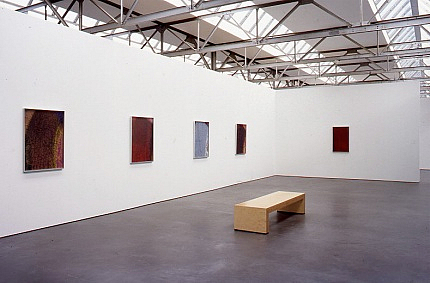For the expressive, at times almost violent-looking paintings of the Austrian artist Arnulf Rainer (Baden, 1929), an existing depiction has almost always served as the point of departure up to now. For decades he has painted, with vehement or subtle gestures, over the underground formed by such a depiction. Though this starting point can be obscured entirely, it is usually at least partially visible, and the presence of the original depiction continues to have an effect on the result.
Rainer makes such Ubermalungen, or `paintings over', on old engravings of landscapes, for instance, or on photographs of himself, the body twisted into all sorts of poses and the face contorted into grimaces. His way of working emphasizes the act of painting. The painting assumes the character of a deliberate act - of destruction or affirmation, of protest or resignation.
Considerable controversy arose when Rainer produced Ubermalungen on photographs of dead people. In these Toten-übermalungen, Rainer first seems to caress the dead face in the depiction and to follow every trace of death, then to smear the paint wildly and aggressively across the image with his fingers, as if in fierce protest.
During The Opening, the exhibition with which De Pont started its activities in 1992, a number of paintings by Arnulf Rainer were already shown in Tilburg. The most recent works were, at that time, paintings which had the form of a cross and which were made with expressive strokes and effusions of paint. In a certain respect, it was as though Rainer was hereby returning to the painting as a `primary' creation - thus abandoning a point of departure that had existed prior to this. Plain white linen now served as the underground for the painting.
The cross, however, is by no means a neutral form for a canvas, as is indeed the case with a square or a rectangle. As `shaped canvases', Rainer's crosses even go a step further than those of the American artist Frank Stella, who used erratic forms during the sixties as a means to emphasize the object-like quality of the painting. The effect of the cross as a symbol is so strong, that the shape completely determines the object, whatever material is used. The cross is, as it were, the object of objects. Seen as such, Rainer's act of painting onto these plain canvases can also be regarded as `painting over' which, again and again, covers, violates, gives majesty to, subdues, intensifies and depletes the sacred symbol with his own expressiveness.
In a number of respects, the continuity that these Microstructures have in relation to Rainer's earlier work seems to be more substantial than the break that could be deduced from the calm mood and the direct way in which they have been painted. The compositions of the Microstructures have everything to do with instability: the paint seems to be poured across the canvas in a particular direction or drips slowly downward across the surface, as though the cardboard carrier is merely the path for this fluid movement. The dense bands or veils of color comprise a barrier which the eye cannot actually penetrate - a suggestion that also arises in many of Rainer's Ubermalungen.
From a close proximity, it is moreover possible to see that the surface of the painting has been worked with a sharp object. And while the injuries to the surface express a certain aggression, each work gives rise to other associations as well. Depending on the underground, the network of scratches makes one think, for instance, of scratches in ice or crevices in dried earth. In the Microstructures, it is as though Rainer has first produced the depictions that he then revises. In the act that is carried out on the surface of the work, the theme of life being threatened does emerge again, but at the same time Rainer seems to create a new sense of life, through the associations that he evokes with a range of organic structures.
